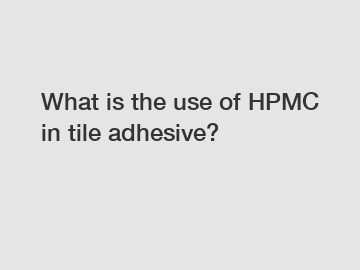What is the use of HPMC in tile adhesive?
What is the use of HPMC in tile adhesive?
The use of Hydroxypropyl Methylcellulose (HPMC) in tile adhesive has become increasingly popular in the construction industry. This versatile compound offers numerous benefits that enhance the performance and quality of tile adhesives. From improving consistency and workability to promoting strong adhesion, HPMC plays a crucial role in ensuring the success of tile installations. Let's delve deeper into the uses of HPMC in tile adhesive.
1. Enhancing Workability:

HPMC acts as a rheology modifier, which means it improves the flow and workability of tile adhesives. By incorporating HPMC into the adhesive formulation, installers can achieve a smooth and easy-to-apply consistency. This makes the adhesive easier to spread and ensures a more uniform coverage on the tile and substrate. Additionally, HPMC reduces the risk of adhesive sagging, which is particularly important when using large-format tiles.
2. Water Retention:
Tile adhesives containing HPMC offer excellent water retention properties. HPMC forms a film that traps water within the adhesive, preventing premature drying. This prolonged water retention allows installers more time to adjust tiles during installation, ensuring better alignment and minimizing the risk of tiles shifting. Moreover, the prolonged water retention enhances the hydration process, promoting proper curing of the adhesive and maximizing its final strength.
3. Improved Adhesion:
HPMC significantly enhances the adhesive bond between tiles and substrates. When included in tile adhesive formulations, HPMC forms a thin film on the tile surface, which acts as a bonding agent. This film ensures excellent adhesion between the adhesive and both the tile and the substrate. The enhanced bond strength reduces the risk of tiles detaching over time, enhancing the longevity and durability of the tiled surface.
4. Crack Resistance:
Tile adhesives reinforced with HPMC exhibit improved crack resistance. The presence of HPMC fibers within the adhesive matrix helps to disperse stresses and distribute them more evenly across the tiled surface. This reduces the likelihood of cracks developing due to movements or substrate variations. The crack resistance properties of HPMC-based adhesives are particularly valuable when installing tiles in high-traffic areas or regions prone to extreme temperature fluctuations.
In conclusion, the use of Hydroxypropyl Methylcellulose (HPMC) in tile adhesive offers several significant advantages. The addition of HPMC enhances the workability of the adhesive, ensuring a smooth consistency that is easy to apply. HPMC also improves water retention, allowing installers more time to adjust tiles and promoting proper curing. The strong adhesive bond created by HPMC guarantees the longevity and durability of the tiled surface. Additionally, the crack resistance properties of HPMC-based adhesives ensure the longevity of the tile installation. With these benefits in mind, it is no wonder that HPMC has become an essential ingredient in high-quality tile adhesives. So, if you're looking for a tile adhesive that provides excellent workability, strong adhesion, and crack resistance, choose one that incorporates HPMC.
Want more information on petroleum coke carburizing agent manufacturers, Peach Shell Activated Carbon, petroleum coke carburizing agent manufacturers? Feel free to contact us.


